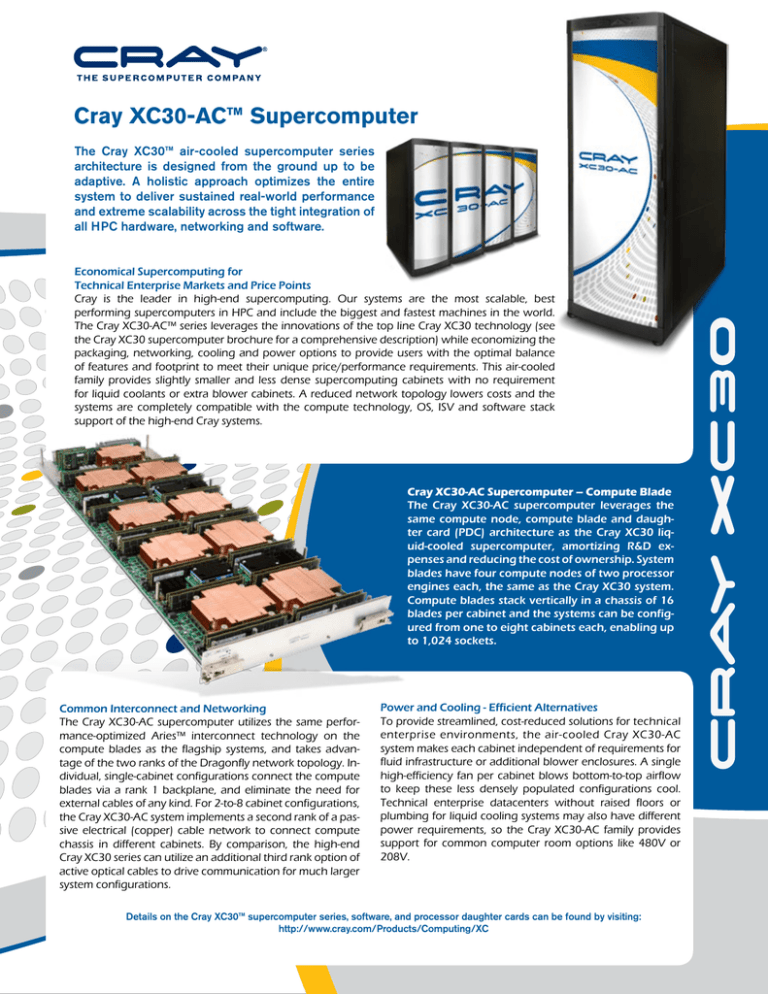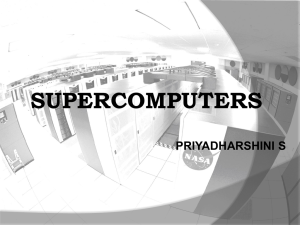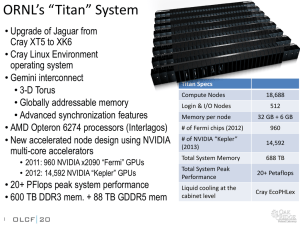
red trademark, Cray XC30, Cray Linux Environment, Cray SHMEM, and NodeKare are trademarks of Cray In.
Cray XC30-AC™ Supercomputer
The Cray XC30™ air-cooled supercomputer series
architecture is designed from the ground up to be
adaptive. A holistic approach optimizes the entire
system to deliver sustained real-world performance
and extreme scalability across the tight integration of
all HPC hardware, networking and software.
Economical Supercomputing for
Technical Enterprise Markets and Price Points
Cray is the leader in high-end supercomputing. Our systems are the most scalable, best
performing supercomputers in HPC and include the biggest and fastest machines in the world.
The Cray XC30-AC™ series leverages the innovations of the top line Cray XC30 technology (see
the Cray XC30 supercomputer brochure for a comprehensive description) while economizing the
packaging, networking, cooling and power options to provide users with the optimal balance
of features and footprint to meet their unique price/performance requirements. This air-cooled
family provides slightly smaller and less dense supercomputing cabinets with no requirement
for liquid coolants or extra blower cabinets. A reduced network topology lowers costs and the
systems are completely compatible with the compute technology, OS, ISV and software stack
support of the high-end Cray systems.
Cray XC30-AC Supercomputer – Compute Blade
The Cray XC30-AC supercomputer leverages the
same compute node, compute blade and daughter card (PDC) architecture as the Cray XC30 liquid-cooled supercomputer, amortizing R&D expenses and reducing the cost of ownership. System
blades have four compute nodes of two processor
engines each, the same as the Cray XC30 system.
Compute blades stack vertically in a chassis of 16
blades per cabinet and the systems can be configured from one to eight cabinets each, enabling up
to 1,024 sockets.
Common Interconnect and Networking
The Cray XC30-AC supercomputer utilizes the same performance-optimized Aries™ interconnect technology on the
compute blades as the flagship systems, and takes advantage of the two ranks of the Dragonfly network topology. Individual, single-cabinet configurations connect the compute
blades via a rank 1 backplane, and eliminate the need for
external cables of any kind. For 2-to-8 cabinet configurations,
the Cray XC30-AC system implements a second rank of a passive electrical (copper) cable network to connect compute
chassis in different cabinets. By comparison, the high-end
Cray XC30 series can utilize an additional third rank option of
active optical cables to drive communication for much larger
system configurations.
Power and Cooling - Efficient Alternatives
To provide streamlined, cost-reduced solutions for technical
enterprise environments, the air-cooled Cray XC30-AC
system makes each cabinet independent of requirements for
fluid infrastructure or additional blower enclosures. A single
high-efficiency fan per cabinet blows bottom-to-top airflow
to keep these less densely populated configurations cool.
Technical enterprise datacenters without raised floors or
plumbing for liquid cooling systems may also have different
power requirements, so the Cray XC30-AC family provides
support for common computer room options like 480V or
208V.
Details on the Cray XC30™ supercomputer series, software, and processor daughter cards can be found by visiting:
http://www.cray.com/Products/Computing/XC
Cray XC30-AC™ Series Specifications
Processor
Memory
Compute Cabinet
Interconnect
System Administration
64-bit Intel® Xeon® processor E5 family: up to 128 per cabinet
32-128GB per node
Memory bandwidth: up to 117GB/s per node
Up to 128 sockets per cabinet, upgradeable with processors of varying core counts
Peak performance: initially up to 33 TFLOPS per system cabinet
1 Aries routing and communications ASIC per four compute nodes
48 switch ports per Aries chip (500GB/s switching capacity per chip)
Dragonfly interconnect: low latency, high bandwidth topology
Cray System Management Workstation (SMW)
Single-system view for system administration
System software rollback capability
Integrated Cray Hardware Supervisory System (HSS)
Reliability Features (Hardware)
Reliability Features (Software)
Operating System
Compilers, Libraries & Tools
Independent, out-of-band management network
Full ECC protection of all packet traffic in the Aries network
Redundant power supplies; redundant voltage regulator modules
Redundant paths to all system RAID (configuration dependent)
Hot swap power supplies and compute blades
Integrated pressure and temperature sensors
HSS system monitors operation of all operating system kernels
Lustre file system object storage target failover; Lustre metadata server failover
Software failover for critical system services including system database, system
logger and batch subsystems
NodeKARE (Node Knowledge and Reconfiguration)
Cray Linux Environment (includes SUSE Linux SLES11, HSS and SMW software)
Extreme Scalability Mode (ESM) and Cluster Compatibility Mode (CCM)
Cray Compiler Environment, Intel Compiler, PGI Compiler, GNU compiler
Support for the ISO Fortran standard (2008) including parallel programming using
coarrays, C/C++ and UPC
MPI 2.0, Cray SHMEM, other standard MPI libraries using CCM; Cray Apprentice and
CrayPat performance tools; Intel Parallel Studio Development Suite (option)
Job Management
PBS Professional job management system
Moab® Adaptive Computing Suite job management system
External I/O Interface
SLURM – Simple Linux Unified Resource Manager
InfiniBand, 10 Gigabit Ethernet, Fibre Channel (FC) and Ethernet
Disk Storage
Full line of FC, SAS and IB based disk arrays with support for FC and SATA disk drives,
SONEXION data storage system
Parallel File System
Lustre, Data Virtualization Service (DVS) allows support for NFS, external Lustre and
other file systems
30 kW per compute cabinet, maximum configuration
Power
Support for 480, 400, 230, 208 and 200 VAC computer rooms
Cooling
Dimensions (Cabinet)
Air cooled with bottom to top airflow: 3,000 cfm intake
H 80.75 in. x W 27.65 in. x D 64.00 in.
Weight (Cabinet)
1,500 lbs maximum operational
1,800 lbs maximum shipping
EMC: FCC Part 15 Subpart B, CE Mark, CISPR 22 & 24, ICES-003, C-tick, VCCI
Regulatory Compliance
Safety: IEC 60950-1, TUV SUD America CB Report
Acoustic: ISO 7779, ISO 9296
a registered trademark, Cray XC30,Cray
Cray Linux
Cray
SHMEM,Suite
and NodeKare
trademarks
of Cray
In.
Inc. Environment,
• 901 Fifth
Avenue,
1000 •areSeattle,
WA
98164
• Tel: 206.701.2000 • Fax: 206.701.2500 • www.cray.com
ther countries. All other trademarks
mentioned
are the properties
ofare
their
respective
20121024JRC
© 2013
Cray Inc. Allherein
rights reserved.
Specifications
subject
to changeowners.
without notice.
Cray is a registered trademark and Cray XC30, Cray Linux Environment, CrayPat and the Cray logo are trademarks of Cray Inc.
Intel, Xeon, Aries and the Intel logo are trademarks of Intel Corporation in the U.S. and/or other countries. All other trademarks mentioned herein are the properties of their respective owners. 20131015EMS








